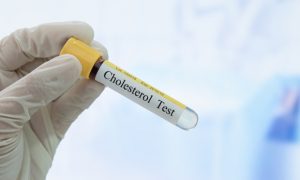 Balancing your HDL—good cholesterol—and LDL—bad cholesterol—is important to help reduce the risk of heart disease and stroke, but how can you manage your cholesterol ratio? Read on to discover why a healthy cholesterol ratio is important, as well as how to calculate your cholesterol ratio, ideal ratios, the pros and cons of total cholesterol testing, and how often your levels should be checked.
Balancing your HDL—good cholesterol—and LDL—bad cholesterol—is important to help reduce the risk of heart disease and stroke, but how can you manage your cholesterol ratio? Read on to discover why a healthy cholesterol ratio is important, as well as how to calculate your cholesterol ratio, ideal ratios, the pros and cons of total cholesterol testing, and how often your levels should be checked.
Does cholesterol ratio matter?
Your cholesterol ratio can tell you whether you need to change your lifestyle in order to reduce the risk of heart disease. The body needs HDL cholesterol to carry the LDL cholesterol back to the liver, where it can be removed. This LDL cholesterol is bad for your heart, and while it is important to try to keep its level low, a higher level of HDL cholesterol is beneficial to aiding in heart health.
How to calculate cholesterol ratio?
Advertisement
Your cholesterol ratio can be calculated by getting a cholesterol test at your physician’s office. Before the test, be sure to abstain from food and drinks for nine to 12 hours prior. Water is usually permitted, but any other liquids like coffee or sodas should be avoided. Be sure to advise your doctor of any medications that you’re taking, as certain ones may affect cholesterol levels.
The results of your test will have three numbers: your total cholesterol, your total HDL, and your total LDL. To calculate your cholesterol ratio, divide the number of your total cholesterol by the number of your total HDL. For example, if your total cholesterol is 200 and your HDL is 50, your cholesterol ratio would be 4:1, or 4.
What should your cholesterol ratio be?
The ideal cholesterol ratio is 4:1, with total cholesterol being below 200mg/dL, LDL between 100-129mg/dL, and HDL at 40mg/dL or higher for men and 60mg/dL or higher for women. Women may have higher levels of HDL because they have more estrogen.
Total cholesterol, HDL, LDL, and triglyceride testing: The pros and cons
There are multiple versions of cholesterol tests available. Check out the list below to review the pros and cons of each and help decide which is best suited to your needs.
Total cholesterol: A total cholesterol test is the most affordable and efficient option, as it doesn’t require fasting beforehand. These tests can be completed at home and measure only your total cholesterol—they are a good option for those who have a low risk of heart disease. A reading of 200 or lower is good, while 200-239 is almost high, and 240+ is high. The issue with these tests is that they do not specify whether or not HDL or LDL levels specifically are too low or too high, making it suitable for only a general idea of your cholesterol level.
Total cholesterol and HDL: Testing HDL levels in addition to total cholesterol allows you to calculate your cholesterol ratio and can give you a better idea as to whether you are at risk for developing heart disease. If your total cholesterol level is high, but your cholesterol ratio is low, the high total cholesterol number may not signify an increased risk of heart disease, rather an abundance of good HDL cholesterol.
LDL cholesterol: These tests are completed to help assess the risk of heart disease and determine an appropriate treatment. For those who have a generally low risk of developing heart disease, an LDL of less than 100 is ideal; however, if you’re at higher risk, then an LDL of 70 or lower is best. Testing the LDL requires fasting for approximately 12 hours prior, as triglyceride levels jump 20 percent after a meal, which could alter the results.
LDL is calculated by using the following formula: LDL = Total Cholesterol – HDL – (Triglycerides / 5). Unfortunately, if your triglyceride level is higher than 250, the calculation becomes less exact.
Related: VLDL cholesterol: Tests, function, and home remedies
Cholesterol ratio: Risk for men and women
The risks associated with cholesterol ratios differ for men and women. Men double their risk of developing heart disease if their ratio reaches 9.6, while the risk is half of the average if their ratio is 3.4. In comparison, women’s risk of heart disease doubles if their ratio hits 7, while the average risk is halved if their cholesterol ratio is 3.3.
Related: Cholesterol deposits around the eyes: Causes and natural remedies
When to get your cholesterol tested
Advertisement
It is important to get your cholesterol checked regularly if you are 40 or older, though other factors could warrant more frequent testing. Cholesterol testing is recommended if you have a family history of early cardiovascular disease, have been diagnosed with coronary heart disease, peripheral arterial disease, have suffered a stroke or mini-stroke, are overweight or obese, or have a condition such as pancreatitis, kidney disease, or an underactive thyroid.
Your cholesterol ratio can provide you with a more in-depth look at your LDL and HDL levels, which will give you a better understanding of your risk of developing heart disease, as well as help you gain a more complete picture of your health.
Related: Natural cholesterol reducers: Alternative foods and therapies to lower cholesterol
